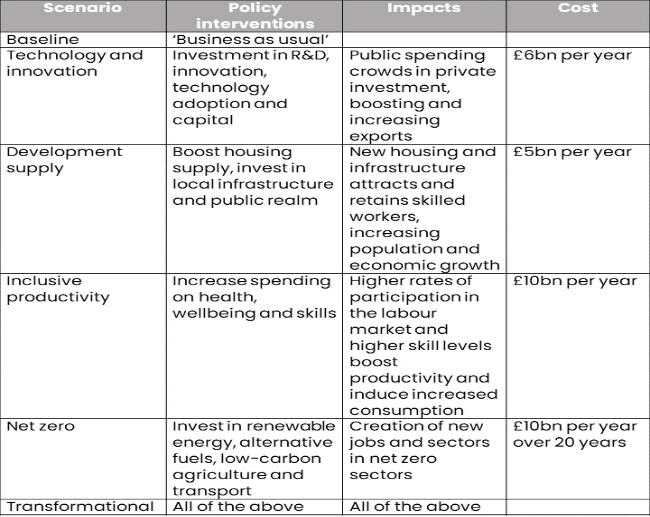The Northern Powerhouse Independent Economic Review: can ‘transformational’ growth be delivered?
Posted on: 7 December 2023 by Tom Arnold in Blog

Heseltine Institute Research Associate Dr Tom Arnold reflects on the new Northern Powerhouse Independent Economic Review and discusses whether the right policy levers are available to deliver the ‘transformational’ economic growth it proposes.
Transport for the North (TfN) has published its new Northern Powerhouse Independent Economic Review (NPIER), a major piece of economic research identifying the strengths, weaknesses and underlying trends shaping the economy of Northern England. The first NPIER was published in 2016 and formed a central part of the evidence base informing TfN’s Strategic Transport Plan and plans for Northern Powerhouse Rail (NPR).
Much has changed in the Northern policy landscape in the intervening period. NPR has been significantly downgraded by government, with proposals now focusing on improvements to existing infrastructure rather than new high speed lines. HS2 will now stop at Birmingham, with Phase 2 to Manchester and Leeds cancelled. The UK’s exit from the European Union and the COVID-19 pandemic have impacted labour markets and trading conditions for Northern businesses, and legislation committing the UK to achieve net zero carbon emissions by 2050 presents challenges as well as opportunities. TfN itself is a slimmer and arguably less powerful organisation than in 2016, following reductions in its funding from central government.
In the absence of other governmental institutions operating at a pan-Northern scale, TfN is not just a transport body, but the de facto economic development agency for the region and an important forum for collaboration between Northern England’s increasingly high-profile city-region leaders. Almost a decade on from George Osborne’s promise to create a ‘Northern Powerhouse’, the NPIER provides an intriguing snapshot into the political economy of this region of 15 million residents. However, it also raises questions about which institutions are equipped to deliver the policies that could improve the region’s economic performance.
The Northern England economy in 2023
What has changed since 2016? The big picture is familiar. Productivity growth in Northern England is very low by historical and international standards, standing at 0.1% a year compared to a pre-Global Financial Crisis trend of 1.9%. Jobs growth has been strong and unemployment remains low – a feature of the UK economy more broadly over the last 10 years.
The focus of the new NPIER reflects changes in debates about the Northern economy over recent years. The 2016 version focused on the contribution of a select handful of ‘high value’ sectors which, it suggested, would be the drivers of productivity growth for Northern England. These ‘prime capabilities’ – advanced manufacturing, energy, health innovation and digital – were identified as internationally competitive sectors with high potential for growth. The 2023 NPIER takes a broader approach, noting that two-thirds of employees in the region work in the ‘foundational economy’ – sectors such as health and social care, emergency services and education, which are not considered to be highly productive by traditional measures, but crucial to a functioning economy.
The UK’s legislative commitment to achieving net zero carbon emissions by 2050 also influences the new NPIER. While Northern England is well placed in many ways to benefit from the transition to renewable energy sources, with physical assets suited to the production of wind, tidal and nuclear energy, the region’s carbon-intensive manufacturing sector is likely to face rising costs requiring policy intervention. The rapid growth of hybrid and remote working in the aftermath of the COVID-19 pandemic has also had an impact, reflected in the emphasis on digital connectivity as a ‘cross-cutting driver’ of growth.
Future scenarios
In the context of this new policy environment, the NPIER models six scenarios for the Northern England economy, illustrated in the table below. The ‘transformational’ scenario would, it suggests, close the productivity gap between Northern England and the UK average, creating an additional 1 million jobs and ‘paying for itself’ in the form of £720bn of additional government income and £685bn in private investment by 2050.

Table: Summary of the six NPIER scenarios (adapted from NPIER)
Are the policy levers available to deliver ‘transformational’ change to the Northern economy?
The ‘transformational’ scenario identified by TfN appears a more distant prospect than in 2016. A recent report from the Resolution Foundation suggests the UK is 15 years into a period of almost unprecedented stagnation. Meanwhile, the cancellation of HS2 Phase 2 suggests UK government is unwilling or unable to deliver the type of major infrastructure project that might contribute to turning around the North’s poor economic performance. There is no quick fix to Northern England’s economic malaise, but the NPIER makes the case for a combination of R&D spending, housebuilding, health and education and transport infrastructure over the next 25 years to bring the North’s cities in line with the economic performance of other mid-size Northern European metropolises.
Whether change on this scale can be delivered by central government is questionable, and the UK has a poor record of developing consistent and long-term approaches to improving regional economic performance. As work from the Productivity Institute has outlined, overly centralised policymaking and high levels of policy churn have contributed to the UK’s weak economic performance outside a handful of sub-regions. Further devolution to metro mayors and combined authorities – building on the recent ‘trailblazer’ deals in Greater Manchester and the West Midlands – could provide additional policy levers and resources for local policymakers.
However, TfN’s status as the only pan-Northern governmental institution, and the publication of the new NPIER, only serve to highlight the ‘missing middle’ in English governance. Along with the transformational policy interventions identified in the NPIER, more thought will be needed on which institutions – and at which scale – are best placed to deliver these policies. With a general election on the horizon in 2024, Northern leaders will need to consider not only their policy ‘asks’ of any incoming government, but the role of regional bodies in improving economic outcomes.
Keywords: .